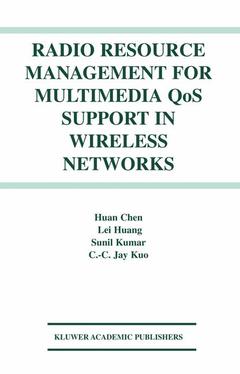Description
Radio Resource Management for Multimedia QoS Support in Wireless Networks, 2004
Authors: Huan Chen , Lei Huang , Kumar Sunil, Kuo C.C. Jay
Language: English
Subject for Radio Resource Management for Multimedia QoS Support in...:
105.49 €
In Print (Delivery period: 15 days).
Add to cart
Radio Resource Management for Multimedia QoS Support in Wireless Networks
Publication date: 10-2012
256 p. · 15.5x23.5 cm · Paperback
Publication date: 10-2012
256 p. · 15.5x23.5 cm · Paperback
Approximative price 105.49 €
Subject to availability at the publisher.
Add to cart
Radio resource management for multimedia QoS supports in wireless networks
Publication date: 10-2003
256 p. · 15.5x23.5 cm · Hardback
Publication date: 10-2003
256 p. · 15.5x23.5 cm · Hardback
Description
/li>Contents
/li>
Due to the great success and enormous impact of IP networks, In ternet access (such as sending and receiving e-mails) and web brows ing have become the ruling paradigm for next generation wireless systems. On the other hand, great technological and commercial success of services and applications is being witnessed in mobile wire less communications with examples of cellular, pes voice telephony and wireless LANs. The service paradigm has thus shifted from the conventional voice service to seamlessly integrated high quality mul timedia transmission over broadband wireless mobile networks. The multimedia content may include data, voice, audio, image, video and so on. With availability of more powerful portable devices, such as PDA, portable computer and cellular phone, coupled with the easier access to the core network (using a mobile device), the number of mobile users and the demand for multimedia-based applications is increasing rapidly. As a result, there is an urgent need for a sys tem that supports heterogeneous multimedia services and provides seamless access to the desired resources via wireless connections. Therefore, the convergence of multimedia communication and wireless mobile networking technologies into the next generation wireless multimedia (WMM) networks with the vision of "anytime, anywhere, anyform" information system is the certain trend in the foreseeable future. However, successful combination of these two technologies presents many challenges such as available spectral bandwidth, energy efficiency, seamless end-to-end communication, robustness, security, etc.
1 Introduction.- 1.1 Quality of Service Issues in Wireless Multimedia Net-works.- 1.2 Resource Management Issues in Cellular Wireless Systems.- 2 Background.- 2.1 Evolution of Wireless Communication Networks.- 2.2 Challenges in Wireless Multimedia Networks.- 2.3 Challenges in Radio Resource Management.- 2.4 QoS in Wireless Multimedia Networks.- 3 Analysis of Connection-Level QoS.- 3.1 Homogeneous Bandwidth Applications.- 3.2 Heterogeneous Bandwidth Applications.- 3.3 Rate-adaptive Applications.- 3.4 Numerical Results.- 3.5 Conclusion and Future Work.- 4 Wireless Networks with Adaptive Resource Management.- 4.1 Adaptive Resource Management System.- 4.2 Analysis for Connection-level QoS Service Model.- 4.3 Simulation and Discussion.- 4.4 Conclusion and Future Work.- 5 Dynamic Call Admission Control Schemes.- 5.1 Dynamic CAC Schemes for CBR Traffic.- 5.2 Dynamic CAC Schemes for VBR Traffic.- 5.3 Simulation Results and Discussion.- 5.4 Conclusion and Future Work.- 6 Handoff Schemes in TDMA/FDMA Systems.- 6.1 Fixed Guard Channel Handoff Scheme with Multiple Thresholds.- 6.2 Dynamic Guard Channel Handoff Scheme.- 6.3 Simulation Results and Discussion.- 7 Handoff Schemes in CDMA Systems.- 7.1 Introduction.- 7.2 Overview of Capacity and Load Estimation in CDMA Systems.- 7.3 Proposed IGM Scheme.- 7.4 Simulation Results.- 7.5 Conclusion and Future Work.- 8 Radio Resource Management with MDP.- 8.1 Introduction to MDP and CAC Policy.- 8.2 2-D MDP and Optimal CAC Policy in Homogeneous Handoff Systems.- 8.3 3-D MDP and Optimal CAC Policy.- 8.4 Simulation Results and Discussion.- 8.5 Complexity of the MDP using Linear Programming Approach.- 9 Future Trends.- 9.1 Summary of Research.- 9.2 Future Work.
© 2024 LAVOISIER S.A.S.



